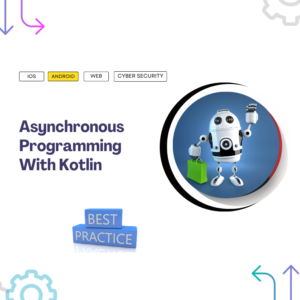
In the world of programming, two paradigms stand out: Object-Oriented Programming (OOP) and Functional Programming (FP). Each has its own approach to structuring code and solving problems. Kotlin, a versatile and expressive programming language, seamlessly combines these paradigms. In this blog, we’ll delve into the key differences and distinctions between OOP and FP in the context of Kotlin
Think of OOP as building with LEGO blocks. Each block represents an object that has certain properties (color, size) and actions (connect, disconnect). In the programming world, objects are like those LEGO blocks — they bundle together data and the functions that work on that data.
Let’s say we’re building a zoo simulation. In OOP, we’d create objects like ‘Animal’ or ‘Zookeeper’. An ‘Animal’ object could have properties like ‘name’ and ‘age’, and methods (functions) like ‘eat()’ or ‘makeSound()’. These objects can interact, and we can organize them into classes and hierarchies for easier management.
Now, imagine building with building blocks that can transform themselves. Functional Programming is like a series of transformations on data. You give it input, it processes it, and gives you an output. It’s like a recipe — you follow the steps and get your delicious cake at the end!
In our zoo example, we’d focus on functions that take inputs and produce outputs, without altering the original data. So, instead of changing the ‘Animal’ object directly, we’d create functions like ‘feedAnimal(animal)’ that return a fed animal without modifying the original. It’s like magic — input goes in, transformed output comes out!
What is the difference between functional programming and OOP?
Functional Programming emphasizes data transformations through pure functions, avoiding side effects. Object-Oriented Programming uses objects to encapsulate data and behavior, promoting interaction between entities.
| Aspect | Functional Programming (FP) | Object-Oriented Programming (OO) |
|---|---|---|
| Approach to Data | Emphasizes immutability, pure functions, and data transformation through functions. | Focuses on bundling data and methods within objects that interact with each other. |
| State Management | Prefers immutability and avoids shared state to minimize side effects. | Often involves managing state within objects, which can lead to mutable state. |
| Data Transformation | Relies on functions for operations like mapping, filtering, and reducing over data. | Objects collaborate and modify data through methods within their encapsulated state. |
| Complexity Handling | Breaks down complexity with composable functions and predictable code. | Encapsulates complexity by representing real-world entities as objects and classes. |
Is Kotlin object-oriented or functional?
Kotlin is a programming language that is designed to be both object-oriented and functional. It combines elements from both paradigms, allowing developers to write code using whichever style best fits the problem at hand.
What is functional programming vs OOP in Kotlin?
Object-Oriented Programming (OOP) in Kotlin
At its core, OOP revolves around the concept of objects, classes, and their interactions. Kotlin fully supports OOP principles, offering a rich set of features:
- Objects and Classes: In Kotlin, classes are defined using the
classkeyword. Objects (instances) are created from classes, encapsulating both data and behavior. - Inheritance and Polymorphism: OOP encourages inheritance, allowing classes to inherit properties and behavior from other classes. Kotlin supports single class inheritance and interfaces, promoting polymorphism.
- Encapsulation: Encapsulation involves bundling data and methods that operate on that data within a single unit (class). Kotlin’s access modifiers (
private,protected,public,internal) control the visibility of class members. - State and Behavior: OOP models real-world entities as objects with both state (attributes/properties) and behavior (methods/functions). This makes it intuitive to structure code around real-world concepts.
- Mutable State: OOP languages often use mutable state, where object properties can be modified after creation. This can sometimes lead to unintended side effects and bugs.
- Imperative Style: OOP often employs an imperative programming style, where code specifies how to perform tasks step by step.
Functional Programming (FP) in Kotlin
FP is rooted in the concept of treating functions as first-class citizens. Kotlin’s support for FP provides an alternative perspective:
- First-Class Functions: FP considers functions as values that can be assigned to variables, passed as arguments, and returned from other functions. Kotlin makes this possible.
- Immutable Data: FP promotes using immutable data structures to prevent unintended side effects. Kotlin’s
data classallows creating immutable data classes with ease. - Higher-Order Functions: Kotlin supports higher-order functions, which can take other functions as parameters or return them. This enables a more modular and reusable code structure.
- Pure Functions: FP advocates for pure functions that produce consistent outputs for the same inputs and have no side effects. These functions are easier to test and reason about.
- Functional Composition: FP encourages composing functions to build complex operations by chaining simpler functions together, promoting code reuse.
Combining Paradigms in Kotlin: Kotlin is renowned for its ability to seamlessly combine OOP and FP. Developers can choose the best paradigm for each situation, leading to more flexible and readable code.
Object-Oriented Programming Example:
Consider a simple scenario where we model a bank account using OOP principles.
class BankAccount(private val accountHolder: String, private var balance: Double) {
fun deposit(amount: Double) {
balance += amount
}
fun withdraw(amount: Double) {
if (amount <= balance) {
balance -= amount
} else {
println("Insufficient funds!")
}
}
fun getBalance(): Double {
return balance
}
}
fun main() {
val account = BankAccount("John Doe", 1000.0)
println("Initial balance: ${account.getBalance()}")
account.deposit(500.0)
println("Balance after deposit: ${account.getBalance()}")
account.withdraw(300.0)
println("Balance after withdrawal: ${account.getBalance()}")
}
Functional Programming Example:
In this example, we’ll calculate the sum of squares of even numbers using functional programming concepts.
fun main() {
val numbers = listOf(1, 2, 3, 4, 5, 6, 7, 8, 9, 10)
val sumOfSquaresOfEvens = numbers
.filter { it % 2 == 0 } // Filtering even numbers
.map { it * it } // Mapping to squares
.reduce { acc, square -> acc + square } // Reducing by summing
println("Sum of squares of even numbers: $sumOfSquaresOfEvens")
}
In this functional programming example, we use a combination of higher-order functions such as filter, map, and reduce to achieve the desired result. This code snippet demonstrates how functional programming emphasizes immutability and the composition of functions to solve problems.
By examining these examples, you can see the distinctive approaches of Object-Oriented Programming and Functional Programming in Kotlin. OOP revolves around defining classes and objects to represent entities, while FP focuses on transforming data through function composition and immutability. Kotlin’s flexibility allows you to leverage the strengths of both paradigms to write clean, maintainable, and efficient code.
Can you combine object-oriented and functional programming?
Absolutely, you can indeed combine Object-Oriented Programming (OOP) and Functional Programming (FP) within the same codebase. This approach is often referred to as a “hybrid” style, where you leverage the strengths of both paradigms to write clean and effective code. Here’s a simple Kotlin example that demonstrates this combination:
// Object-Oriented Part
class Student(val name: String, val age: Int) {
fun greet() {
println("Hi, I'm $name and I'm $age years old!")
}
}
// Functional Part
fun filterAdults(students: List<Student>): List<Student> {
return students.filter { it.age >= 18 }
}
fun main() {
val studentList = listOf(
Student("Alice", 20),
Student("Bob", 17),
Student("Charlie", 22),
Student("David", 16)
)
println("Original Student List:")
studentList.forEach { it.greet() }
val adults = filterAdults(studentList)
println("\nAdult Students:")
adults.forEach { it.greet() }
}
In this example:
- The
Studentclass is an Object-Oriented representation of a student, with properties and a method to greet. - The
filterAdultsfunction is written in a Functional style. It takes a list ofStudentobjects, uses thefilterfunction to extract adult students (age 18 and above), and returns a new list. - In the
mainfunction, both paradigms are combined. ThestudentListis created using OOP principles. Then, thefilterAdultsfunction is called in a Functional style to get adult students and print their greetings.
This showcases how OOP and FP can harmoniously coexist in a single program, each contributing their strengths to solve different aspects of a problem.
Feel free to follow and join my email list at no cost. Don’t miss out — sign up now!
Please check out my earlier blog post for more insights. Happy reading!
The Innovative Fundamentals of Android App Development in 2023
How to learn Android App Development in 2023 – Full Guide For Beginners using Kotlin Language
Ultimate Guideline on How to Use ViewModel Design Pattern
What is the Repository Pattern in Android? A Comprehensive Guide
What is ViewModel in Android? A Good Guide for Beginners
The Innovative Fundamentals of Android App Development in 2023
How to Say Goodbye to Activity Lifecycle and Say Hello to Compose Lifecycle ?
How to Monitor/Observe Network Availability for Android Projects



